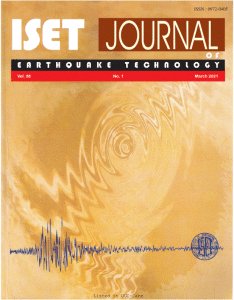Home > Issues & Journals
A comparative prognostic damage scenario of non-engineered masonry and traditional assam type housing in guwahati urban centre
Jayanta Pathak, Nripendra Nath Patwari and Biswajit Sarma
Paper No.: 552
|
Vol.: 57
|
No.: 1
|
March, 2020
|
pp. 43-59

Abstract
The extent of damage to buildings and the resultant loss of life due to most of the earthquakes are attributed largely to vulnerable building typology and their construction practices. These various construction practices often have characteristics that address the prevalent local conditions of weather and other environmental and natural hazards and have evolved based on technology transferred from one generation to the next by word of mouth or through some documentations by practicing masons and end-users. The “Assam type housing” is one such as traditional housing, which has been known for its earthquake-safe construction, using timber as a basic framing material. This traditional housing has been replaced in large numbers by the modified “Assam type looking” masonry housing and this modified housing in masonry has become the conventional building typology in Assam, and different parts of northeast India. The present work attempted to examine the seismic vulnerability of the Guwahati urban centre due to the unscientific transformation of building typology from traditional housing, constructed in timber to more vulnerable housing in unconfined or partially confined masonry constructions. A prognostic damage scenario for the traditional housing in comparison to the conventional housing in unconfined / partially confined and confined masonry buildings have been developed. The damage probability values for various building typologies were adopted and the damage ratios, which represent the ratio of repair or reconstruction cost to the replacement cost for the various typologies of buildings, were used to estimate the economic loss in each municipal ward of the city. The objective of the work is to develop a simplified prognostic damage scenario with first-order approximations of building typology based damage grades for various earthquake intensities as given by Arya and Agarwal [3]. The estimated economic losses based on the prognostic damage scenarios indicate that the estimated losses, which are directly related to the structural damage, have increased many folds due to the transformation from earthquake-safe traditional housing to more vulnerable housings in unconfined or partially confined masonry constructions.
Keywords: Assam Type Housing, Masonry, Builing Typology, Vulnerabilty, Damage, Economic Loss
©2025. ISET. All Rights Reserved.